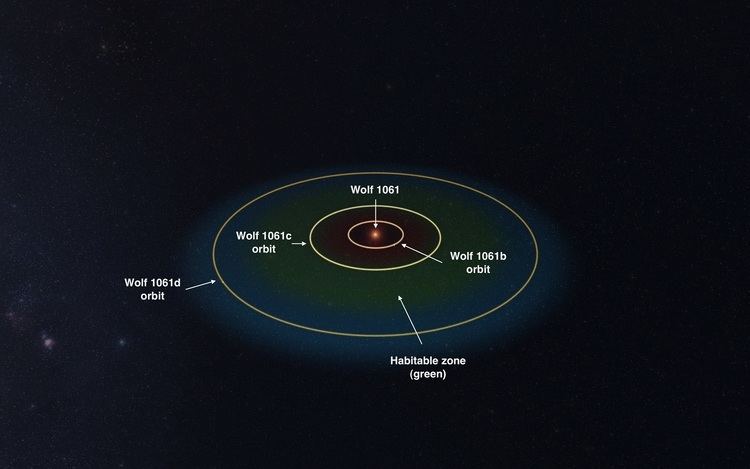Luminosity (bolometric) 0.01102±0.00027 L☉ Temperature 3305 ± 46 K B−V color index +1.57 | Luminosity (visual, LV) 0.0015 L☉ Radius 0.3207±0.0088 R☉ U−B color index +1.20 Parallax (π) 232.98 ± 1.60 mas | |
 | ||
Similar Lacaille 9352, Struve 2398, YZ Ceti, DX Cancri, EZ Aquarii | ||
Wolf 1061c super earth is spotted just 14 light years away
Wolf 1061 (also known as HIP 80824 and V2306 Ophiuchi) is an M class red dwarf star located about 13.8 light years away in the constellation Ophiuchus. It is the 36th closest known star system to the Sun and has a relatively high proper motion of 1.2 seconds of arc per year. Like many red dwarfs, it most likely has a long rotation period of more than 100 days, although it is difficult to measure accurately. Wolf 1061 is very stable and most likely does not have any significant activity such as sunspots or flares. It also does not have any unusual spectroscopic features. The star was first cataloged in 1919 by German astronomer Max Wolf when he published a list of dim stars that had high proper motions. Wolf 1061's name originates from this list. The star has a stellar rotation period of 89.3±1.8~ days. A seven years study found no evidence of photometric transits and confirms the radial velocity signals are not due to stellar activity. The Habitable Zone estimate for the system, lies between 0.11-0.21 AU and 0.09–0.23 AU.
Contents
Planetary system
In December 2015, a team of astronomers from the University of New South Wales announced the discovery of three planets orbiting Wolf 1061. The planets were detected by analyzing 10 years of observations of the Wolf 1061 system by the HARPS spectrograph at La Silla Observatory in Chile. The team used archive radial velocity measurements of the star's spectrum in the HARPS data and, along with 8 years of photometry from the All Sky Automated Survey, discovered two definite planets with orbital periods of around 4.9 and 17.9 days and a very likely third with a period of 67.3 days.
All three planets have masses low enough that they are likely to be rocky planets similar to the inner planets of the Solar System although their actual sizes and densities are currently unknown. However, this information could be determined if the planets happen to transit in front of Wolf 1061 when viewed from Earth. Because all three planets orbit close to the star and have short orbital periods, there is a chance that this will occur. The University of New South Wales team estimated the chances of a transit at around 14% for planet b, 6% for planet c, and 3% for planet d.
One of the planets, Wolf 1061 c, is a super-Earth located near the inner edge of the star's habitable zone, which extends from approximately 0.073 to 0.190 AU. It is one of the closest known potentially habitable planet to Earth after Proxima b. The next planet out, Wolf 1061 d, could be marginally habitable depending on its atmosphere's composition as it orbits just beyond the habitable zone.
